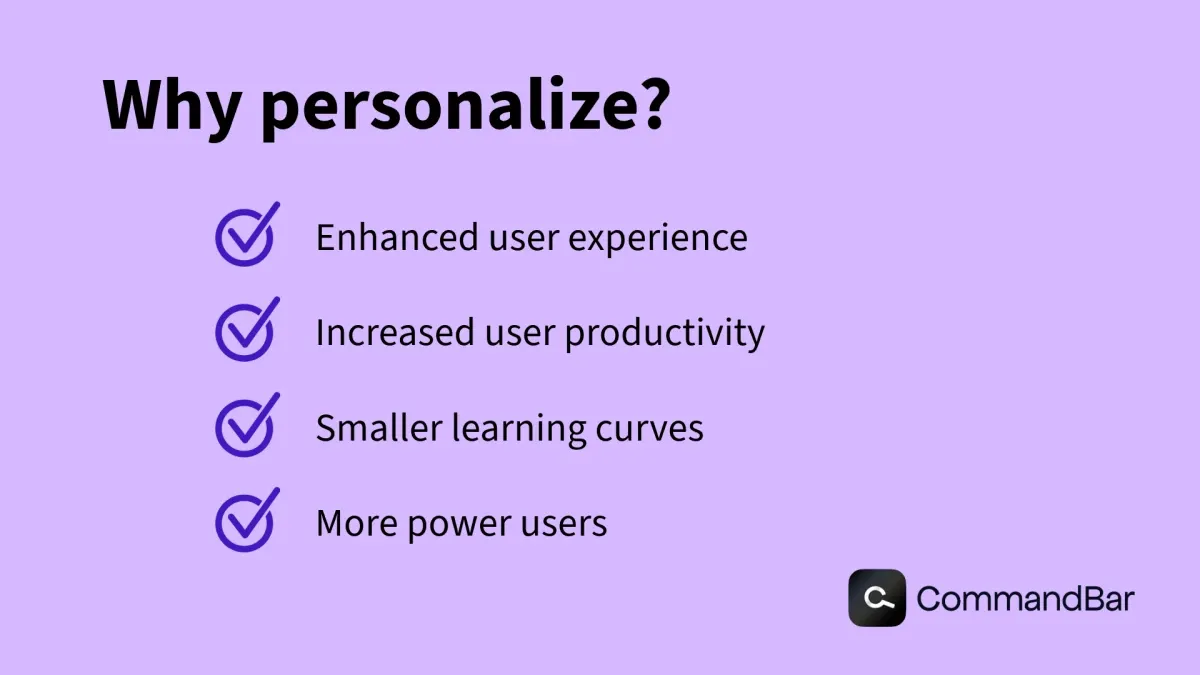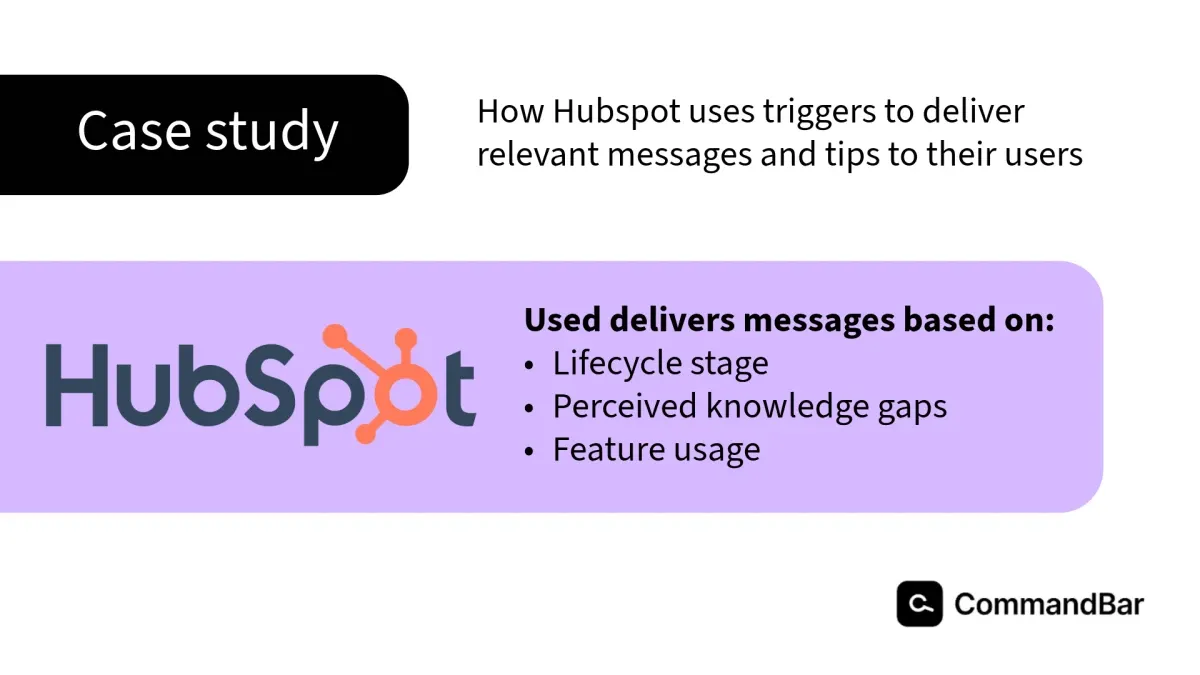Technology is evolving, and it means that customers are getting pickier.
For B2C consumers, 47% of them expect fully or mostly personalized content when getting help with a product or service, This number shoots up to 72% when we’re talking about B2B consumers.
And these users are increasingly savvy. They’re no longer impressed by seeing their name, company, or industry inserted into a message. They want deep, real-time personalization that is genuinely helpful, not just showy.
The power of SaaS personalization
Personalized marketing content constantly gets its flowers for its ability to draw in new customers. But sometimes, the importance of the personalization you bake in on the product side gets overlooked, and we think this is a mistake.
In-product personalization is one of the best revenue drivers for SaaS products. In fact, companies that are growing quickly get 40% more of their revenue from personalization than slower-growing companies.

This basically means that companies that invest in data-driven personalization are getting a headstart on all of their competitors. As a product person, you are at the epicenter of a major revenue-generating operation.
Why is this?
Personalization helps you leverage all of the valuable user data that you likely already have at your fingertips to create custom-built user experiences. No two of your users are exactly the same, so personalization helps you harness that, crafting their experience based on their needs and curiosities in real time.
Real-time personalization could be anything from helpful pop-ups and nudges to chat assistance, or any customized content your users receive when they have their hands on your product.
What you stand to gain
Before we get into the how of it all, let’s talk a little more about the why.

Enhanced user experience
It’s simple. People have a more enjoyable experience when it feels like the experience was created just for them.
Although this already seems like common sense, we can also look to the actual evidence for proof. In a study conducted by the University of Chicago, “irrelevant information weakens consumers’ belief in the product’s ability to deliver the benefit.”
In other words, not only can real-time personalization improve your user experience, but not employing personalization and instead blastic generic messages in your product can actually be alienating to groups of people to whom those messages don’t apply, knocking your user experience down a few pegs.
Increased productivity in your product
When you provide personalized messages in your product, you’re boosting your customer engagement, meaning their productivity in your product goes up.
With custom-tailored tips, tricks, and reminders, it’s easier for them to use your product for the reason that they signed up for it. It can also help them potentially uncover new, maybe unexpected ways to get value out of your product.
For example, for large-scale businesses, understanding user behavior is crucial, and an enterprise headless CMS provides the tools to analyze this behavior, allowing for more effective content and feature personalization.
Smaller learning curves
No matter how complex your product is, strategic personalization can simplify it. When you custom-tailor in-app engagement opportunities to your user’s specific habits, it makes any ramp-up period intuitive.
If you’re intentional about matching their step in the journey, their behavior, or any other kind of user data you have available about them to the messages and tips they get in your product, it empowers them to navigate the platform quicker and independently.
More power users
And the advantage of more productivity and shorter time to surpass learning curves? More power users.
The quicker and easier someone can grasp the true power of your product, the more likely they are to not only remain loyal to you and upgrade to more advanced features, but they’re also more likely to evangelize your product throughout their team or even the entire organization. Power users are infectious.
But how can you do real-time personalization in a scalable way?
The old-fashioned way of doing personalization relied heavily upon your customer success team tracking engagement or starting conversations with customers and manually sending individual suggestions.
The result of this is either overworked CS teams or lackluster personalization.
Luckily, we live in 2024 where technology makes the previously impossible, possible.
Bake in triggers
The easiest way to start implementing real-time personalization is to pre-program triggers. Once a certain event occurs, an in-app message, nudge, or pop-up appears in front of your user.
This isn’t one-to-one personalization, but it’s a great place to start testing the waters with personalization.
To decide on the most relevant (and helpful) triggers, you want to create really strong and well-defined personas. When you lay out your main product personas and can map pain points, questions, and desires to specific personas, you’re able to proactively anticipate what kind of messages may be helpful and at what moments.
So even if they’re not getting a totally unique experience, they still feel understood.
Hubspot is a great example of this.

They send out tips in-app messages and tips based on a user’s stage in the lifecycle (i.e. brand new users or established users) and detected knowledge gaps. They also deliver helpful educational content to continue to nurture the customer relationship. For example, if a user spends most of their time in the email marketing section of their product, they may point them to a guide with best practices for email marketing in Hubspot.
Let the users ask what they want
People say they’re getting burned out on chatbots, but really they’re just getting burned out on bad chatbots. When a chat feels more conversational and human-like, user experience is enhanced.
This is one of the best ways to use AI in personalization. With products like our Copilot, users can ask questions in their own, natural language and get answers quickly.
You can bump them over to a relevant article, give them answers back in their own language, or connect them to an agent as a last resort. This is the ultimate real-time personalization because instead of static knowledge base documents and script-following chat agents, Copilot is dynamic and self-learning, making the experience feel natural to your users.
Once people get used to what essentially feels like an always-on-call assistance, they get comfortable using it to explore the full capabilities of your platform, instead of just using it as a tool when they need support.
Imagine how many times a user has thought “I wonder if I can do X with this” but never asked because it was too much of a hassle. Features like this make it simple to get answers quickly and encourage them to explore all of their curiosity about your platform.
This leads to more meaningful engagement, and since engagement and retention are closely intertwined, this really impacts your company’s growth.
Use their data to tell a story
Perhaps the most innovative way to deliver personalization at scale is using data on usage or behavioral patterns to deliver unique insights in an engaging and digestible way.
Using advanced algorithms, you can automatically take on a more “curatorial” role and make it easier for your users to get value from your platform while hardly lifting a finger themselves.
The most popular example of this is Spotify.

People look forward to reviewing their Spotify Wrapped at the end of each year. And throughout the year they receive other personalized insights they can actually use, like the Discover Weekly playlist that suggests a playlist of new songs every Monday based on their recent listening patterns.
This can easily be translated into a B2B environment, too, and we predict that this will only become more popular with the rise of AI. Consider platforms automatically generating reports based on the metrics users are tracking in-platform or giving them productivity reminders, or any other helpful resources provided based on the previous actions of a specific user.
Essentially, the best way to personalize the experience is to try to read your users’ minds and predict what they need next. AI can’t get you all the way there, but it’s pretty close.
Personalization is easier than ever (and more essential than ever)
If marketing personalization was the first frontier, product personalization is the new frontier. It’s still at the point where you can use personalization as a competitive advantage, but pretty soon it will be table stakes. So if real-time personalization isn’t already on your radar, it should be now.
We’re going to assume if you’re on this blog that you’re at the cutting edge of the product space. You’re actively looking for strategies to set your product apart from the rest, and to pull your weight in the fight to help your company outlast the countless other SaaS companies out there. Personalization is right at that cutting edge now.
Luckily, there is a growing wealth of purpose-built technology like Command AI’s Copilot to help you implement and scale this personalization in a meaningful way. You no longer have to rely on your customer success team’s time and can instead put your users in the driver’s seat, letting them ask what they want, in their own language, and giving them instant, relevant answers.
So what we’re saying is, you have no excuse not to personalize.

















